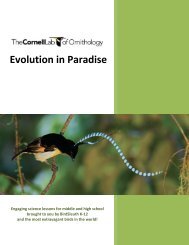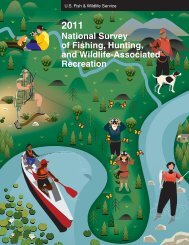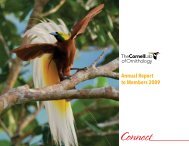Global reach:DATAdiscovering nest sites in haitiBlack-capped Petrels, once thought <strong>to</strong> beextinct, are still critically endangered. But efforts<strong>to</strong> protect them have been stymied by lack <strong>of</strong>knowledge about their cliffside nest burrows.In 2008, James Goetz (now a <strong>Cornell</strong> <strong>Lab</strong> Ph.D.student) spearheaded expeditions along the forestedcliffs <strong>of</strong> Haiti <strong>to</strong> search for petrel breedingcolonies. Since then, Goetz has worked with theU.S. Fish and Wildlife Service, and local partnerslike Grupo Jaragua and Fondation Seguin,<strong>to</strong> find more than 30 petrel nesting locations—yielding a bounty <strong>of</strong> petrel nesting biology datawhere once there was a black hole.Training<strong>Cornell</strong> <strong>Lab</strong> Ph.D. student JamesGoetz and partners in the DominicanRepublic snapped one <strong>of</strong> thefirst pho<strong>to</strong>s <strong>of</strong> a Black-capped Petrelchick in a mountain<strong>to</strong>p cave in Haiti.Safeguarding Thrush habitat in HispaniolaAbout 90 percent <strong>of</strong> the global Bicknell’s Thrush population winters inHispaniola. This is a species in serious decline, with fewer than 40,000individuals left. To keep tabs on wintering Bicknell’s Thrushes, and <strong>to</strong> identifyand protect critical habitat, the <strong>Cornell</strong> <strong>Lab</strong> and partners such as theVermont Center for Ecostudies conducted bird-moni<strong>to</strong>ring workshops inthe Dominican Republic and Haiti. The <strong>Lab</strong>’s scientists trained universitystudents and park rangers in mist netting, bioacoustics surveys, and radiotelemetry. Haitian and Dominican biologists are now gathering data for aconservation plan that combines economic incentives, protected reserves,and forest res<strong>to</strong>ration <strong>to</strong> safeguard Bicknell’s Thrush wintering grounds.James GoetzPutting ItAll Togetherin CubaCuba is critical habitat for birds. TheCuban Archipelago is the winter home ormigra<strong>to</strong>ry flyway for 229 species <strong>of</strong> NorthAmerican breeding birds, including 98 percen<strong>to</strong>f Ospreys from the eastern United States andCanada and 80 percent <strong>of</strong> U.S. Black-throatedBlue Warblers. The <strong>Cornell</strong> <strong>Lab</strong> <strong>of</strong> <strong>Ornithology</strong>has been working for the past 10 years on cooperativeconservation projects in Cuba. The effortbegan with <strong>Cornell</strong> <strong>Lab</strong> and Cuban scientistsconducting joint bird-survey expeditions in<strong>to</strong>remote rainforests <strong>to</strong> identify wintering habitatfor Neotropical birds. The surveys also foundcritical habitat for endangered Cuban endemics,such as the Fernandina Flicker (one <strong>of</strong> the world’srarest woodpeckers) and the world’s smallestbird—the Bee Hummingbird (2 inches tall andweighing less than a penny). Over ensuing years,<strong>Lab</strong> scientists, educa<strong>to</strong>rs, and audio expertsreturned <strong>to</strong> teach field ornithology courses andacoustic moni<strong>to</strong>ring workshops. The <strong>Lab</strong> andCuban partners produced and shipped 7,000CDs <strong>of</strong> the first all-Cuban bird audio guide and10,0000 copies <strong>of</strong> Aves de Cuba—a Spanish-languageCuban bird field guide—<strong>to</strong> be distributed10
yProviding what international partners need <strong>to</strong> protect species around the worldNATURALEZA/ GUÍAS DE CAMPO“Este es un trabajo impresionante, una guía de campo excepcionalmente completa delas aves de Cuba, un valioso libro que llenará el vacío existente por mucho tiempoen la literatura, escri<strong>to</strong> por los colegas que conocen mejor de observación de aves enCuba.”—John Faaborg, Universidad de Missouri, Columbia“Es el primer libro dedicado enteramente a las aves de Cuba publicado en losúltimos ochenta años. Aves de Cuba es un trabajo serio, que mantiene la tradiciónde las obras de don Ramón de la Sagra, Johannes Gundlach y Thomas Barbour.Con una vasta cantidad de nueva información, mapas de distribución y admirablesilustraciones, este es un compendio de la Orni<strong>to</strong>logía cubana y una excelente guía decampo.”—Davis W. Finch, WINGS“Apoyados en la experiencia de <strong>to</strong>da una vida de trabajo en su país natal, OrlandoGarrido y Arturo Kirkconnell han producido una guía verdaderamente completaque será esencial para <strong>to</strong>dos aque los que anhelen disfrutar el placer de la excitantebelleza de las aves cubanas.”—James W. Wiley, al frente del GramblingCooperative Wildlife Project, Universidad de GramblingLa riqueza y diversidad de las aves de Cuba comprende 369 especiesregistradas, representantes de 20 órdenes y 63 familias, con 26 especiesendémicas que incluyen a la encantadora Pedorrera, al lamativo y eleganteTocororo (ave nacional), el colorido carpintero verde y el ave más pequeñadel mundo, el Zunzunci<strong>to</strong>. Esta compacta guía de referencia contiene 51láminas a <strong>to</strong>do color y 662 imágenes que ilustran los plumajes del macho,hembra y juvenil (en algunos casos por primera vez). Muchas especiesmigra<strong>to</strong>ria son ilustradas con los colores durante la época invernal (noreproductiva) o plumaje de verano (reproductiva). Estas imágenes nosproporcionan un panorama de las aves de Norteamérica, tal como aparecenen sus cuarteles invernales.Aves de CubaAves de Cubapor Orlando H. Garridoy Arturo KirkconnellIlustraciones por Román CompañyPrólogo por John W. FitzpatrickToolsEnabling Chileans <strong>to</strong> Tune In <strong>to</strong> their Blue WhalesIn 2003, Chilean scientists discovered a summer nursery for blue whales, one<strong>of</strong> the world’s most endangered species, <strong>of</strong>f the coast <strong>of</strong> Patagonia. To protectthis sensitive habitat, conservationists needed <strong>to</strong> learn more. So researchers atthe Universidad Austral de Chile used deep-sea audio recording devices fromthe <strong>Cornell</strong> <strong>Lab</strong>’s Bioacoustics Research Program. After six months, the Chileanscientists began analyzing the underwater recordings at the <strong>Lab</strong>’s SoundAnalysis Workshop. The need for acoustic recording in this nearly pristinearea is time-sensitive because increasing human intrusion for eco<strong>to</strong>urismand commerce, including seismic testing for energy resources, will affect theacoustic habitat for all the marine life, and thus their breeding and feeding.Orlando H. Garrido y Arturo Kirkconne l son curadores del MuseoNacional de His<strong>to</strong>ria Natural de Cuba. El fa lecido Román Compañy fueun excelente ilustrador de las aves deCuba y su fauna. John W. Fitzpatrickdirige e labora<strong>to</strong>rio de orni<strong>to</strong>logía de Corne l.En la portada de libro se ilustran seis de las especies endémicas de Cuba,que incluyen al Tocororo (extremo superior derecho), debajo de este laPedorrera y a su izquierda y en vuelo, el Zunzunci<strong>to</strong>. A continuación y pordebajo de es<strong>to</strong>s el Sijú Platanero ocupa el centro, que tiene a su izquierdaal Tomeguín del Pinar. En el extremo inferior izquierdo el Pechero y en elderecho, la Paloma Perdiz.<strong>Cornell</strong> <strong>Lab</strong> staff and Cuban biologistson a bird-survey expedition at HumboldtNational Park in Cuba.Coms<strong>to</strong>ck/Corne l PaperbacksCORNELL UNIVERSITY PRESSCOPIA COMPLEMENTARIA,PROHIBIDA SU VENTAwww.corne lpress.corne l.edu 10250throughout the country’s parks and schools. Andin April <strong>2012</strong>, the <strong>Lab</strong> brought a cohort <strong>of</strong> Cubanuniversity students <strong>to</strong> Sapsucker Woods in Ithaca,New York, for an intensive bird conservationbiology short-course—perhaps the largest group<strong>of</strong> Cuban student scientists <strong>to</strong> visit the UnitedStates in 50 years. All <strong>of</strong> this work was made possibleby funding from the MacArthur Foundationand the Chris<strong>to</strong>pher Reynolds Foundation. Theseinvestments in Cuban bird conservation will liveon in the talented, trained biologists and accumulatingknowledge there. A decade after <strong>Lab</strong> scientistsfirst arrived in Havana, our partners in Cubaare better trained and equipped <strong>to</strong> protect theirbirds, including wintering Neotropical migrants.Orlando H.GarridoArturoKirkconne loutreachteaching Cloud Forest Kids about birdsIn Guatemala, preserving cloud forests from cutting requires a shift in localattitudes. That means educating the next generation about the importance<strong>of</strong> their cloud forests. With funding from the U.S. Fish & Wildlife Service,local group Community Cloud Forest Conservation is using the <strong>Cornell</strong><strong>Lab</strong>’s BirdSleuth curriculum <strong>to</strong> teach children from eight remote villageschools about their local birds and the incredible biodiversity around them.The students have developed their own Mayan eBird portal where they canidentify birds in their native language and record sightings. The entire programis eligible for USFWS funds from the Neotropical Migra<strong>to</strong>ry Bird Actbecause Golden-winged Warblers winter in these Guatemalan highlands.Now, golden-wings have new advocates in the children <strong>of</strong> the cloud forests.11






